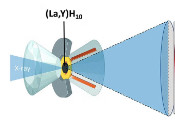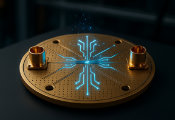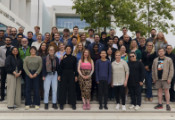Kyoto University Successfully Synthesizes Graphene Nanoribbons for Use as Rare-Earth-Free, Inexpensive, Lightweight, and Rustproof Carbon Magnets
February 20, 2025 -- Professor Hiroshi Sakaguchi and Associate Professor Takahiro Kojima of the Institute of Advanced Energy, Kyoto University, in collaboration with the National University of Singapore and the University of California, Berkeley (USA), announced that they have successfully developed carbon magnets. By designing a precursor molecule and using a unique stereoregularly controlled synthesis method, they succeeded in synthesizing graphene nanoribbons (GNRs), which exhibited magnetic properties by localizing spins of the same orientation on only one side. The GNRs were named "Janus GNRs" after Janus, the two-faced god in Greek mythology. Theoretical calculations showed that the magnetic strength of the GNRs can be tuned via molecular design. These results are expected to lead to the development of lightweight, rustproof, rare-earth-free magnets and were published in the January 9 issue of the international journal Nature.
The origin of a magnet is the spin in matter, and the direction and magnitude of the electron spin reflect the polarity and strength of the magnet. For example, if the upward and downward spins are equal in amount, the material will not show magnetism. Magnets are used in many products such as HDDs and medical equipment. However, current magnets are made of metals, which are highly stable but heavy and undergo rusting. Further, neodymium magnets use rare-earth elements, which encounter supply risks.
In response to this, research has been conducted since the 1980s to produce magnets using carbon, which is inexpensive and abundant. However, the low spin magnitude (weak magnetic force) and stability of carbon have limited its application.
Recently, it was reported that graphene cut into strips with zigzag ends (GNRs) can be theoretically used as magnets. The next step was experimental synthesis, which confirmed spin localization at both ends of the long sides of the strips. However, it was found that the spins at both ends were opposite and canceled each other out, preventing the strips from becoming magnets. It was also predicted that to achieve magnetic properties, the GNRs need to be asymmetric, with one of the sides not having a zigzag structure.
In this international collaboration, the Kyoto University research team designed a precursor molecule (Z-type asymmetric precursor) whose final morphology was an asymmetric zigzag-edged GNR. The team used a unidirectional surface synthesis method that was developed in 2023. Because they are generally unstable in air, GNRs are synthesized as precursors and then linked and assembled in an ultrahigh-vacuum cauldron.
When the precursor molecules are asymmetric, three types of linkage methods can be used: isotactic (linking in one direction), syndiotactic (linking in alternating directions), and atactic (linking in random directions). Asymmetric zigzag-edged GNRs require isotactic linking, and the unidirectional surface synthesis method made the preparation of the GNRs possible.
Specifically, the synthesis method deforms the precursor molecules on the metal substrate, causing them to self-assemble, polymerize, and undergo a dehydrogenative fused-ring reaction. The prepared samples were analyzed by the research team at the National University of Singapore using scanning tunneling microscopy and atomic force microscopy. They confirmed that asymmetric zigzag-edged GNRs with regular protrusions on only one side were synthesized at the atomic level. In addition, electronic state mapping using scanning tunneling spectroscopy confirmed the localization of electron spins on only one side.
The research team at the University of California performed theoretical calculations on the electron spin density of the asymmetric zigzag-edged GNRs based on the assumption that the GNRs are carbon magnets. The results agreed with the experimental values, proving that the synthesized GNRs were indeed magnets. Furthermore, the team systematized the theory further and found that magnetism can be freely controlled by varying the spacing of the opposite projections of the spins.
It was found that the spacing of a six-membered ring (the narrowest) is the most ferromagnetic, the two rings successfully synthesized this time are the second most ferromagnetic, and the three rings are ferrimagnetic (weak magnet).
Sakaguchi said, "Janus-type GNRs are unstable as they are and cannot be taken out of the ultrahigh-vacuum cauldron. We are now aiming to synthesize carbon magnets that can be taken out by introducing protective substituents. We are also working on synthesizing weak carbon magnets to prove that the magnetism of Janus-type GNRs can be freely controlled. There are still many obstacles to overcome before the Janus-type becomes an alternative to neodymium magnets, but I believe that this result will be a very important milestone in the realization of this goal."




































